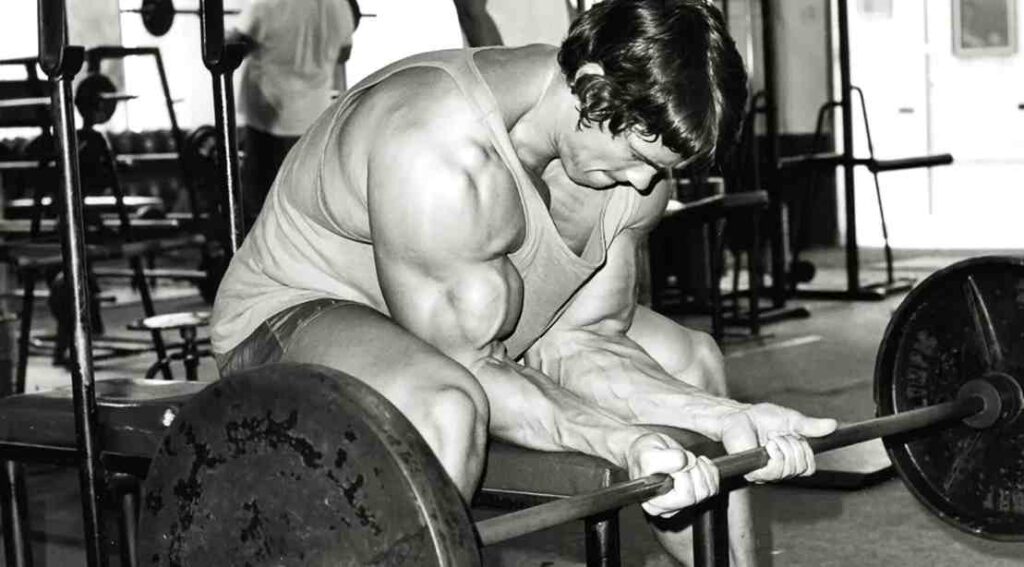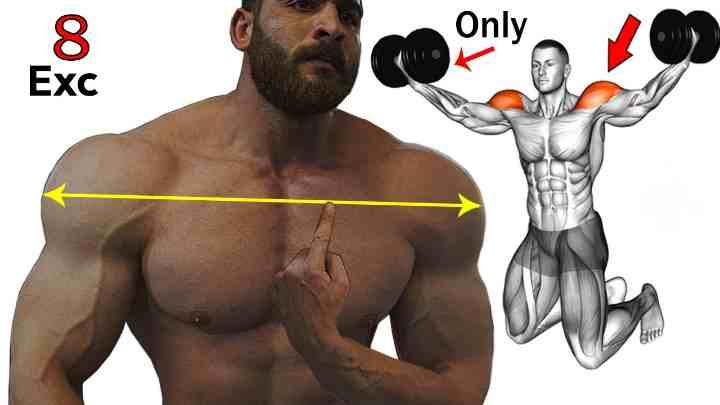If you want strong and well-shaped shoulders, focusing on your front deltoids, or front delts for short is important. These muscles are located at the front of your shoulders and play a big role in many upper-body movements. Strong front delts can help you lift heavier weights, improve your posture, and make everyday tasks easier. In this article, we’ll explore the best front delt exercises, how to do them correctly, and tips to avoid common mistakes. Whether you’re a beginner or an experienced lifter, you’ll find useful information to help you build stronger and healthier shoulders.
Anatomy of the Front Deltoid
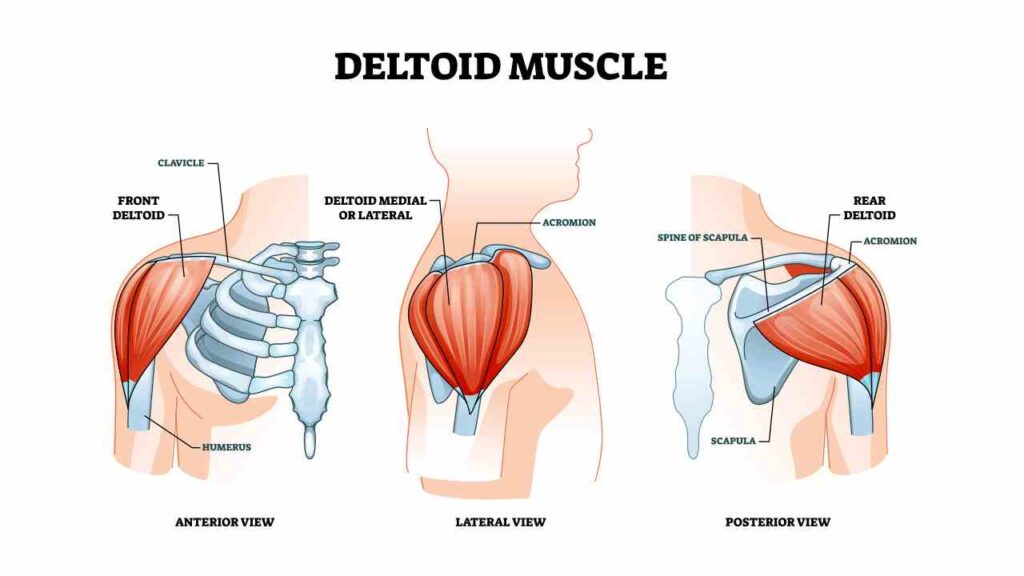
The front deltoid is located at the front part of your shoulder. It originates from the lateral third of the clavicle (collarbone) and inserts into the deltoid tuberosity on the humerus (upper arm bone). This muscle is part of the larger deltoid muscle, which has three distinct heads: anterior (front), lateral (side), and posterior (rear).
Function
The primary functions of the front deltoid include:
- Flexion: Lifting the arm forward, such as when you raise your hand or lift an object in front of you.
- Medial Rotation: Rotating the arm inward, which is essential for movements like throwing a ball or performing a chest press.
- Horizontal Adduction: Moving the arm across the body, as in a hugging motion or when performing a front raise.
Role in Movement
The front deltoid works in conjunction with other muscles, such as the pectoralis major (chest muscle) and the biceps brachii (upper arm muscle), to perform various upper body movements. It is heavily involved in pushing and lifting activities, making it crucial for exercises like bench presses, push-ups, and shoulder presses.
Importance in Training
Training the front deltoid is essential for balanced shoulder development and overall upper-body strength. Strong front delts contribute to better posture, improved shoulder stability, and enhanced performance in sports and daily activities. However, it’s important to train all three heads of the deltoid muscle to avoid muscle imbalances and reduce the risk of injury.
SHOP FOR THE ADJUSTABLE DUMBBELL SET ON AMAZON
Understanding the detailed anatomy and function of the front deltoid can help you perform exercises correctly and achieve better results in your workouts.
13 Best Front Delt Exercises
For effectively targeting and activating the front deltoids, consider including these best front delt exercises in your workout routine:
1. Front Dumbbell Raises

This exercise isolates the front deltoids, enhancing their strength and definition. It’s performed with dumbbells to allow for controlled movements and muscle engagement.
How to Perform:
- Stand with feet shoulder-width apart, holding a dumbbell in each hand, palms facing down.
- Keeping your arms straight, lift the dumbbells directly in front of you to shoulder height.
- Lower the weights slowly back to the starting position.
Tips:
- Maintain a slight bend in your elbows to reduce strain on your joints.
- Focus on a controlled motion, avoiding jerky movements.
Mistakes to Avoid:
- Avoid using excessively heavy weights that compromise your form.
- Don’t swing the dumbbells; the movement should be smooth and deliberate.
2. Barbell Overhead Press

A compound exercise that targets the front deltoids while also engaging the triceps and upper chest. It’s great for overall shoulder development.
How to Perform:
- Stand with your feet shoulder-width apart and grip the barbell slightly wider than shoulder-width.
- Press the barbell overhead until your arms are fully extended.
- Lower the barbell back to the starting position at shoulder height.
Tips:
- Keep your core tight and avoid arching your lower back.
- Use a full range of motion for maximum muscle engagement.
Mistakes to Avoid:
- Avoid leaning back excessively; this reduces shoulder activation.
- Ensure the barbell descends to shoulder height, not lower.
3. Arnold Press
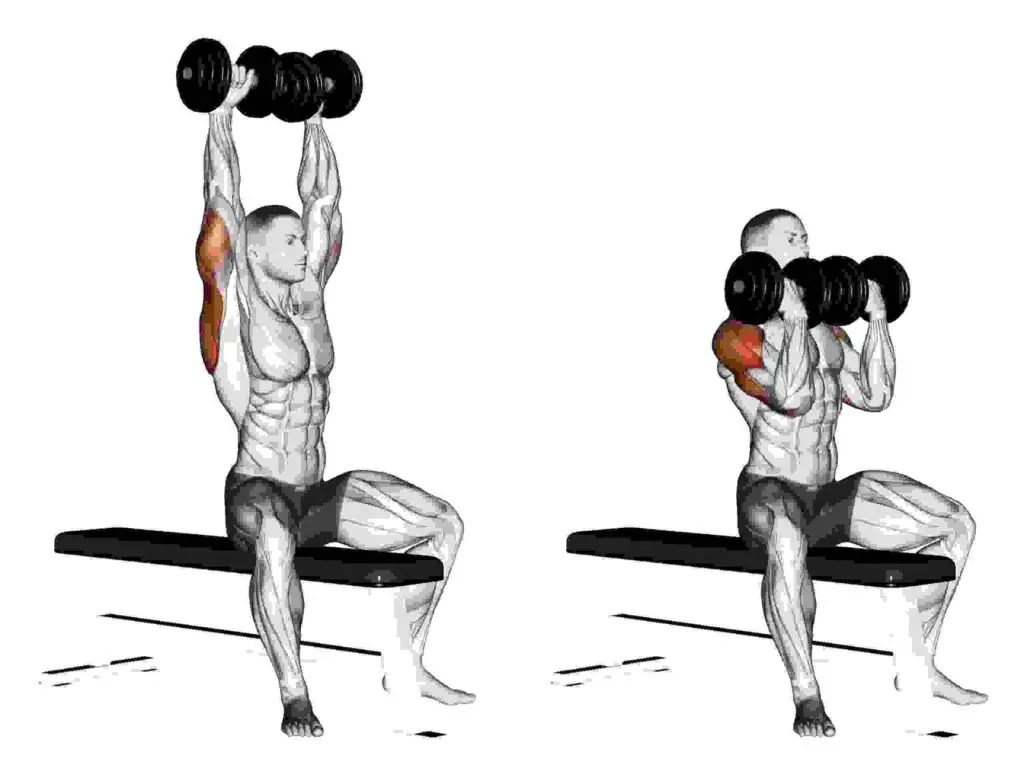
Named after Arnold Schwarzenegger, this variation of the overhead press emphasizes the front deltoids by incorporating a rotation.
How to Perform:
- Start with dumbbells at shoulder height, palms facing you.
- Rotate your palms outward as you press the dumbbells overhead.
- Reverse the rotation to return to the starting position.
Tips:
- Perform the rotation slowly to fully engage the front delts.
- Keep your movements controlled and deliberate.
Mistakes to Avoid:
- Don’t rush the rotation; it should be smooth and intentional.
- Avoid using too much weight, which can compromise form.
SHOP FOR THE RESISTANCE BAND ON AMAZON
4. Cable Front Raises
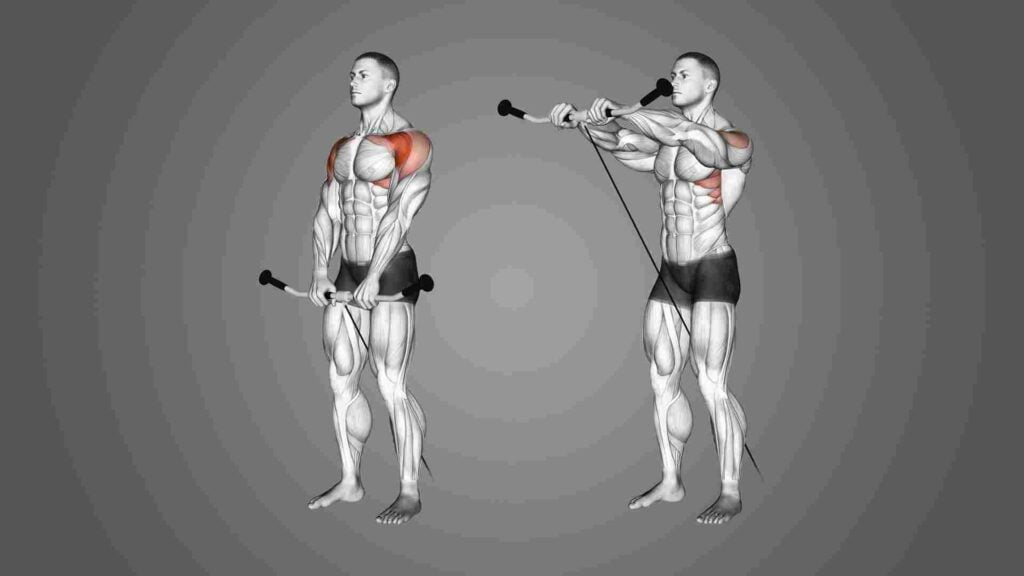
This exercise uses cables to provide constant tension on the front deltoids throughout the movement, enhancing muscle engagement.
How to Perform:
- Stand facing a cable machine with the handle set at the lowest position.
- Grip the handle with one hand and lift it straight in front of you to shoulder height.
- Lower it slowly back to the starting position.
Tips:
- Keep your shoulder blades down and back to maintain proper posture.
- Adjust the weight to ensure you can maintain control throughout the set.
Mistakes to Avoid:
- Avoid using momentum to lift the weight; focus on muscle contraction.
- Don’t let the cable slack during the exercise; maintain tension.
5. Front Plate Raise

This exercise targets the front delts while also engaging the upper chest and core for stability.
How to Perform:
- Hold a weight plate with both hands, arms extended straight in front of you.
- Lift the plate to shoulder height, keeping your arms straight.
- Lower the plate back to the starting position slowly.
Tips:
- Keep your core engaged to stabilize your body.
- Perform the exercise in a controlled manner, focusing on the front delts.
Mistakes to Avoid:
- Avoid bending your elbows or using your legs to assist the lift.
- Don’t use excessively heavy weights; it’s more important to maintain proper form.
6. Military Press
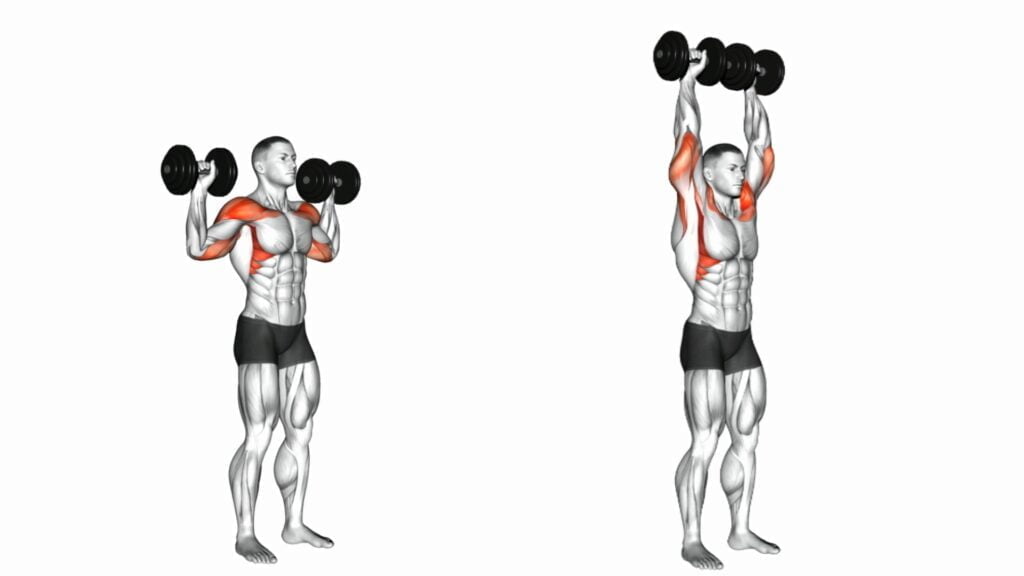
A fundamental exercise for building shoulder strength and mass, focusing heavily on the front deltoids while also engaging the triceps and upper chest.
How to Perform:
- Stand with your feet shoulder-width apart and grip the barbell slightly wider than shoulder-width.
- Press the barbell overhead until your arms are fully extended.
- Lower the barbell back to shoulder height, keeping your elbows slightly in front of you.
Tips:
- Keep your back straight and engage your core to prevent arching.
- Perform the press in a slow and controlled manner for better muscle engagement.
Mistakes to Avoid:
- Don’t use your legs to assist with the lift; focus on your shoulders.
- Avoid lowering the barbell too far behind your head, which can strain the shoulders.
SHOP FOR THE ADJUSTABLE BENCH ON AMAZON
7. Dumbbell Shoulder Press
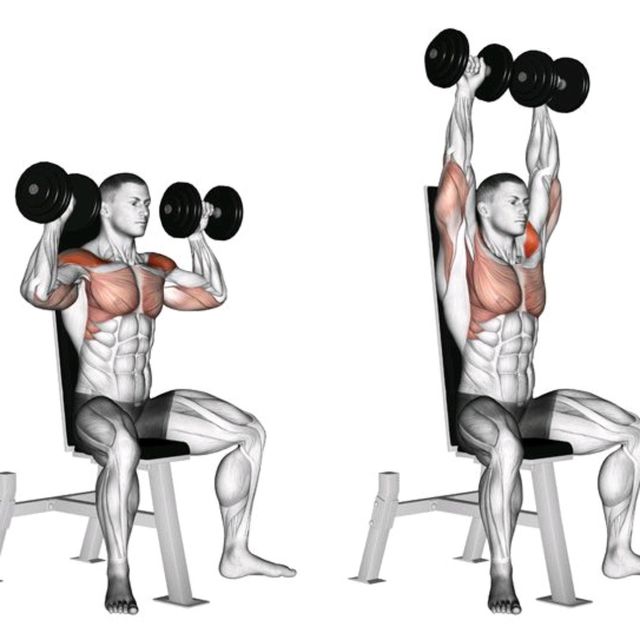
This exercise builds shoulder strength with a focus on the front delts, and also engages the lateral and rear deltoids for overall shoulder development.
How to Perform:
- Sit or stand with a dumbbell in each hand, held at shoulder height with palms facing forward.
- Press the dumbbells overhead until your arms are fully extended.
- Lower the dumbbells back to shoulder height.
Tips:
- Keep your movements smooth and controlled.
- Maintain a neutral spine and avoid leaning back during the press.
Mistakes to Avoid:
- Avoid using too much weight, which can compromise form and lead to injury.
- Don’t let your elbows flare out excessively; they should remain close to your body.
8. Front Plate Raise with Single Arm
A variation of the front raise that focuses on one arm at a time, enhancing the strength and activation of the front deltoid.
How to Perform:
- Stand holding a weight plate with one hand, keeping your arm extended straight in front of you.
- Lift the plate to shoulder height, keeping your arm straight.
- Lower it slowly back to the starting position and switch arms after completing the set.
Tips:
- Engage your core to maintain balance and stability.
- Perform the lift with control to maximize muscle engagement.
Mistakes to Avoid:
- Don’t use momentum to lift the plate; the movement should be deliberate.
- Avoid swinging the arm or using excessive weight that affects form.
9. Upright Row
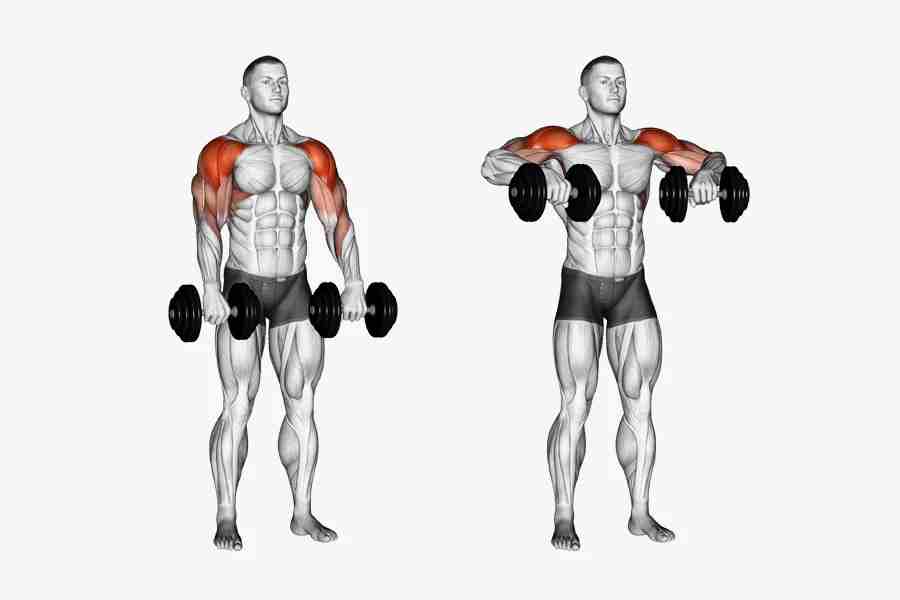
This exercise primarily targets the front deltoids and the traps, helping to build overall shoulder and upper back strength.
How to Perform:
- Stand with feet shoulder-width apart, holding a barbell or dumbbell in front of you with an overhand grip.
- Lift the weight straight up to chest height, keeping your elbows higher than your wrists.
- Lower the weight back to the starting position.
Tips:
- Keep your elbows pointed outwards to emphasize the front delts.
- Avoid using too much weight, which can lead to shoulder impingement.
Mistakes to Avoid:
- Don’t pull the weight up too high; lifting to chest height is sufficient.
- Avoid allowing your shoulders to hunch up; maintain good posture.
10. Dumbbell Front Raise with Twist
This variation of the front raise adds a rotational component to engage the front delts more thoroughly and improve overall shoulder stability.
How to Perform:
- Stand with a dumbbell in each hand, palms facing down.
- Raise the dumbbells to shoulder height while rotating your palms to face upwards.
- Lower the weights back to the starting position, reversing the rotation.
Tips:
- Perform the twist slowly to maximize muscle activation.
- Maintain a stable core and avoid using your legs for assistance.
Mistakes to Avoid:
- Avoid jerky movements during the twist; control the motion.
- Don’t use heavy weights that compromise your form.
SHOP FOR THE PROTEIN POWDER ON AMAZON
11. Seated Dumbbell Front Raise
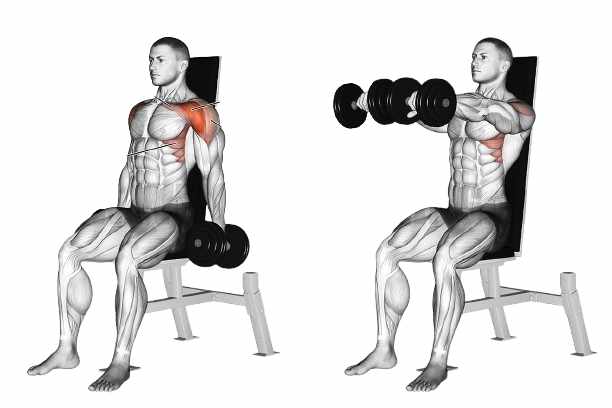
Performing the front raise while seated helps to minimize momentum and isolate the front deltoids more effectively.
How to Perform:
- Sit on a bench with your back straight and feet flat on the floor.
- Hold a dumbbell in each hand, resting them on your thighs.
- Lift the dumbbells straight in front of you to shoulder height, then lower them back down slowly.
Tips:
- Keep your back pressed against the bench to avoid leaning.
- Focus on using the front deltoids to lift the weights, not your legs.
Mistakes to Avoid:
- Don’t arch your back or lean forward during the lift.
- Avoid using momentum to lift the weights; the movement should be controlled.
12. Cable Front Raise (Single Arm)
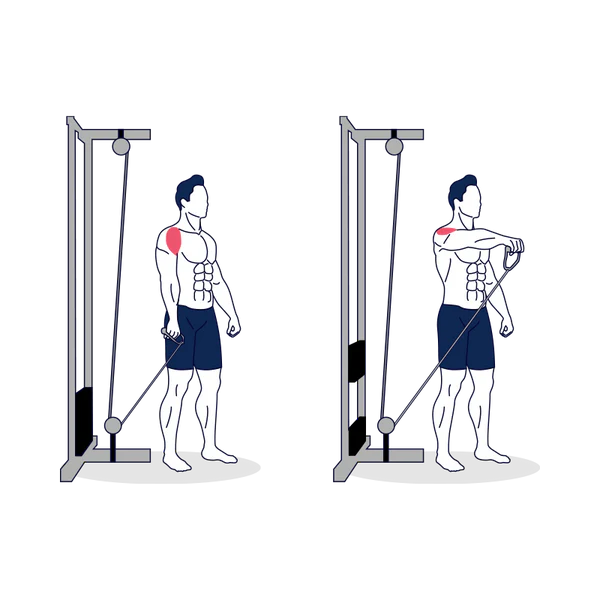
This exercise targets each front deltoid individually, providing balanced strength and muscle development.
How to Perform:
- Stand facing a cable machine with the handle set at the lowest position.
- Grip the handle with one hand and lift it straight in front of you to shoulder height.
- Lower the handle back to the starting position, and then switch arms.
Tips:
- Keep your torso stable and avoid leaning during the lift.
- Adjust the weight so you can complete the movement with proper form.
Mistakes to Avoid:
- Don’t let the cable slack; maintain constant tension.
- Avoid swinging the arm or using excessive weight.
13. Front Dumbbell Raise with Pause
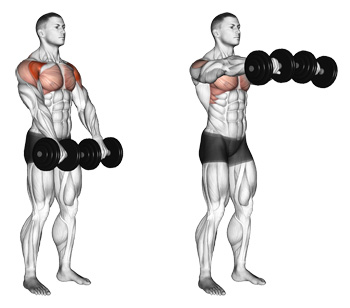
Adding a pause at the top of the front raise increases time under tension, enhancing muscle activation and strength.
How to Perform:
- Stand with dumbbells in front of your thighs, palms facing down.
- Lift the dumbbells straight in front of you to shoulder height, pausing for 1-2 seconds.
- Lower the weights slowly back to the starting position.
Tips:
- Use a controlled pace to maximize the effectiveness of the pause.
- Ensure that your pause is at the top of the movement to keep tension on the front delts.
Mistakes to Avoid:
- Avoid rushing through the pause; it should be deliberate.
- Don’t use weights that are too heavy, which can compromise your form.
SHOP FOR THE FITNESS TRACKER ON AMAZON
Incorporate a mix of these best front delt exercises into your routine, and be sure to adjust the weight and reps based on your fitness level and goals. Remember to warm up properly and stretch to prevent injury and enhance performance.
Benefits of Strong Front Delts
Strong front deltoids offer several benefits that can enhance your overall fitness and daily life. Here are some key advantages:
- Improved Shoulder Stability: Strong front delts help stabilize the shoulder joint, reducing the risk of injuries during various activities, such as lifting, pushing, and throwing.
- Enhanced Upper Body Strength: Front delts play a crucial role in many upper body exercises, including bench presses, push-ups, and overhead presses. Strengthening these muscles can improve your performance in these exercises and increase your overall upper body strength.
- Better Posture: Well-developed front delts contribute to better posture by helping to keep your shoulders aligned and preventing them from rounding forward. This can reduce the risk of developing postural issues and related discomfort.
- Aesthetic Appeal: Strong and defined front delts add to the overall appearance of your shoulders, giving them a more sculpted and balanced look. This can enhance your physique and boost your confidence.
- Functional Fitness: Front delts are involved in many everyday movements, such as lifting objects, reaching overhead, and pushing. Strengthening these muscles can make these tasks easier and more efficient, improving your functional fitness.
- Injury Prevention: By strengthening the front delts, you can reduce the risk of shoulder injuries, such as strains and impingements. Strong muscles provide better support and protection for the shoulder joint.
- Enhanced Athletic Performance: Athletes, especially those involved in sports that require throwing, pushing, or lifting, can benefit from strong front delts. These muscles contribute to better performance and endurance in various sports activities.
By focusing on building strong front delts, you can enjoy these benefits and improve your overall fitness and well-being. Incorporating the best front delt exercises into your workout routine is a great way to achieve these advantages.
Front Delt Development Workout Routines

Creating effective workout routines for the front deltoids can help you build strong and well-defined shoulders. Here are some sample routines for different fitness levels:
Routine 1: Basic Front Delt Focus
1. Front Dumbbell Raises
- Sets: 3
- Reps: 12-15
- Rest: 60 seconds
2. Barbell Overhead Press
- Sets: 4
- Reps: 8-10
- Rest: 90 seconds
3. Arnold Press
- Sets: 3
- Reps: 10-12
- Rest: 60 seconds
4. Cable Front Raises (Single Arm)
- Sets: 3
- Reps: 12-15 per arm
- Rest: 60 seconds
5. Front Plate Raise
- Sets: 3
- Reps: 10-12
- Rest: 60 seconds
Notes:
- Focus on controlled movements and proper form.
- Ensure a full range of motion for each exercise.
Routine 2: Advanced Front Delt Development
1. Military Press
- Sets: 4
- Reps: 6-8
- Rest: 90 seconds
2. Dumbbell Front Raise with Twist
- Sets: 3
- Reps: 12-15
- Rest: 60 seconds
3. Upright Row
- Sets: 3
- Reps: 10-12
- Rest: 60 seconds
4. Seated Dumbbell Front Raise
- Sets: 4
- Reps: 10-12
- Rest: 60 seconds
5. Dumbbell Front Raise with Pause
- Sets: 3
- Reps: 12-15
- Rest: 60 seconds
Notes:
- Incorporate tempo variations to increase muscle tension.
- Focus on engaging the front deltoids throughout each exercise.
Routine 3: Comprehensive Shoulder Routine with Front Delt Emphasis
1. Barbell Overhead Press
- Sets: 4
- Reps: 8-10
- Rest: 90 seconds
2. Front Dumbbell Raises
- Sets: 3
- Reps: 12-15
- Rest: 60 seconds
3. Arnold Press
- Sets: 3
- Reps: 10-12
- Rest: 60 seconds
4. Cable Front Raises
- Sets: 3
- Reps: 12-15
- Rest: 60 seconds
5. Front Plate Raise
- Sets: 3
- Reps: 10-12
- Rest: 60 seconds
6. Lateral Raises (for balanced shoulder development)
- Sets: 3
- Reps: 12-15
- Rest: 60 seconds
Notes:
- Start with compound movements for overall strength and then move to isolation exercises.
- Ensure adequate rest between sets to maintain performance and form.
Effective Leg Exercises with Cable Machine
These routines provide a comprehensive approach to front deltoid development, enhancing both strength and size. Adjust the weights and rest periods based on your fitness level and goals.
FAQs
Q 1. How often should I train my front delts?
Ans. It’s generally recommended to train your front delts 1-2 times per week, allowing for adequate rest and recovery between sessions.
Q 2. Can I train my front delts if I have shoulder pain?
Ans. If you have shoulder pain, it’s important to consult with a healthcare professional before continuing with any shoulder exercises. They can guide safe exercises and modifications.
Q 3. What is the best way to warm up before front delt exercises?
Ans. A good warm-up includes dynamic stretches and light cardio to increase blood flow to the muscles. Specific shoulder warm-up exercises, such as arm circles and shoulder rotations, can also help prepare your front delts.
Q 4. Should I use free weights or machines for front delt exercises?
Ans. Both free weights and machines have their benefits. Free weights, like dumbbells and barbells, allow for a greater range of motion and engage stabilizing muscles. Machines can provide more controlled movements and are often easier for beginners.
Q 5. Can I train my front delts at home without equipment?
Ans. Yes, you can train your front delts at home using bodyweight exercises like push-ups and pike push-ups. Resistance bands are also a great option for adding resistance without needing heavy equipment.
Q 6. What are some signs that my front delts are getting stronger?
Ans. Signs of progress include being able to lift heavier weights, perform more reps, and experience less fatigue during workouts. Improved shoulder stability and better posture are also indicators of stronger front delts.
Conclusion
Strong front deltoids are important for building well-rounded shoulders and improving your overall upper body strength. By including these best front delt exercises in your workout routine, you can target these muscles effectively and enjoy benefits like better posture, increased stability, and enhanced performance in daily activities. Remember to focus on proper form, avoid common mistakes, and gradually increase the intensity of your workouts. With dedication and consistency, you’ll be on your way to stronger and healthier shoulders.

Good day, and welcome to Fitthour. My name is Shubham Vijay, and I am a certified personal trainer and nutrition coach with 6 years of experience in the fitness industry. At Fitthour, we specialize in types of training, such as strength training, cardio, or HIIT, and our mission is to help clients achieve their fitness goals and improve their overall health.

